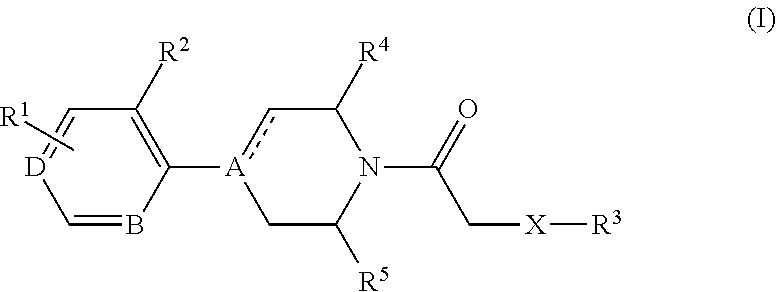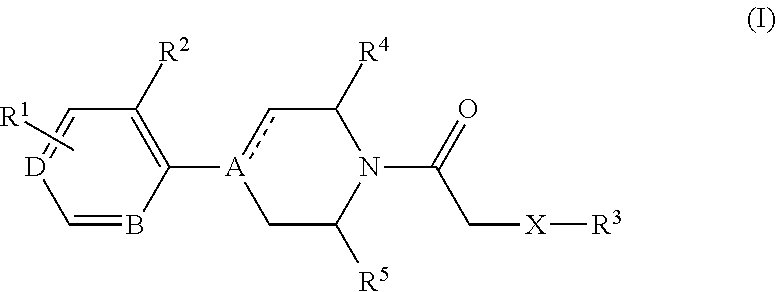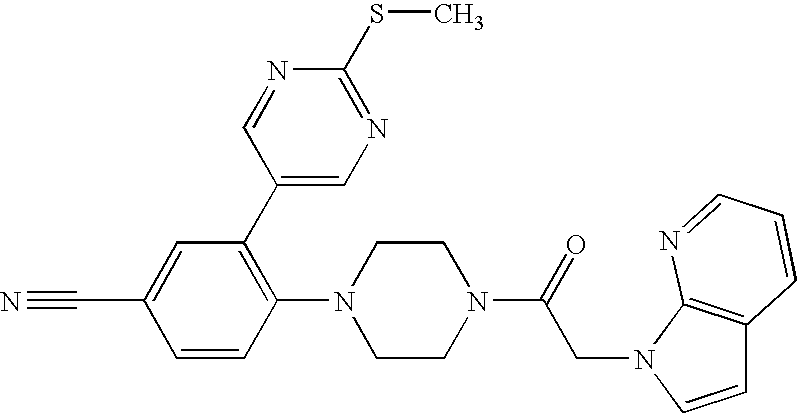Cxcr3 receptor antagonists
a cxcr3 receptor and antagonist technology, applied in the field of cxcr3 receptor antagonists, can solve the problem that no cxcr3 antagonist has been approved as a marketed drug, and achieve the effect of improving the safety and efficacy of cxcr3 receptors
- Summary
- Abstract
- Description
- Claims
- Application Information
AI Technical Summary
Benefits of technology
Problems solved by technology
Method used
Image
Examples
example 1
Synthesis of 1-{4-[2-(2-Methoxy-pyrimidin-5-yl)-phenyl]-piperazin-1-yl}-2-pyrrolo[2,3-b]pyridin-1-yl-ethanone
[0529]
[0530]4-(2-Bromophenyl)-piperazine-1-carboxylic acid, t-butyl ester (10 g, 29.30 mmol) and 2-methoxypyrimidine-5-boronic acid (5 g, 32.48 mmol) are dissolved in DMF (200 mL) under a stream of nitrogen. To this mixture is added a 2M aqueous solution of sodium carbonate (73.26 mL, 150 mmol) followed by bis(triphenylphosphine)palladium (II) chloride (2.06 g, 2.93 mmol). The resulting mixture is allowed to stir at 100° C. for 30 min. A precipitate forms. Water is added and the resulting mixture is filtered to provide a gray colored solid which is air dried. The solid is then re-dissolved in dichloromethane (20 mL) and loaded on a 340 g Biotage SNAP column and eluted with 35% ethyl acetate in hexanes to provide 4-[2-(2-methoxy-pyrimidin-5-yl)-phenyl]-piperazine-1-carboxylic acid t-butyl ester (5.87 g, 54% yield).
[0531]To a solution of the above ester (5.67 g, 15.31 mmol) dis...
example 2
Synthesis of 1-{4-[2-(2-Methoxy-pyrimidin-5-yl)-4-trifluoromethyl-phenyl]-piperazin-1-yl}-2-pyrrolo[2,3-b]pyridin-1-yl-ethanone
[0533]
[0534]To a solution of 2-fluoro-4-trifluoromethylnitrobenzene (1 g, 4.78 mmol) and Hunig's base (2.45 mL, 14.35 mmol) in DMF (10 mL) is added 1-Boc-piperazine (1.14 g, 7.17 mmol). The resulting reaction is allowed to stir at 80° C. in an oil bath for 1 h. Water (30 mL) is added and mixture is extracted with EtOAc. The organic layer is washed with water, brine, dried (Na2SO4) and concentrated. The resulting 4-(2-nitro-4-trifluoromethyl-phenyl)-piperazine-1-carboxylic acid t-butyl ester is isolated as an orange oil (1.80 g, 100%) and is used in the next step without further purification.
[0535]To a solution of the above intermediate (1.80 g, 4.80 mmol) in EtOH (25 mL) is added Pd / C (5% on activated carbon, 100 mg) and the mixture is purged and back filled with H2 three times via a H2 balloon. The resulting reaction is allowed to stir at ambient temperatur...
example 3
Synthesis of 2-(3,5-dimethyl-pyrazol-1-yl)-1-{4-[2-(2-morpholin-4-yl-pyrimidin-5-yl)-phenyl]-piperidin-1-yl}-ethanone
[0541]
[0542]2-(4-Morpholino)pyrimidine-5-boronic acid pinacol ester (300 mg, 1.03 mmol), 1,2-dibromobenzene (243 mg, 1.03 mmol), Bis(triphenylphosphine)palladium (II) chloride (72 mg, 0.10 mmol), aqueous Na2CO3 (2N, 2.58 mL, 5.15 mmol) and DMF (5 mL) are added to a 10 mL microwave tube. Reaction is carried out in a microwave oven at 100° C. for 30 min. The reaction mixture turns black. The mixture is poured into water and extracted with EtOAc. The organic layers are washed with water, brine, dried (Na2SO4) and concentrated. The crude product is purified using biotage eluting with 0-30% EtOAc / Hexane. The desired mono-coupled product elutes at 30% EtOAc. The di-coupled by-product elutes earlier. Removal of the solvent gives 4-[5-(2-bromo-phenyl)-pyrimidin-2-yl]-morpholine as a white solid (130 mg, 39%).
[0543]The above intermediate (150 mg, 0.47 mmol), 3,6-dihydro-2H-pyr...
PUM
| Property | Measurement | Unit |
|---|---|---|
| volume | aaaaa | aaaaa |
| volume | aaaaa | aaaaa |
| temperature | aaaaa | aaaaa |
Abstract
Description
Claims
Application Information
 Login to View More
Login to View More - R&D
- Intellectual Property
- Life Sciences
- Materials
- Tech Scout
- Unparalleled Data Quality
- Higher Quality Content
- 60% Fewer Hallucinations
Browse by: Latest US Patents, China's latest patents, Technical Efficacy Thesaurus, Application Domain, Technology Topic, Popular Technical Reports.
© 2025 PatSnap. All rights reserved.Legal|Privacy policy|Modern Slavery Act Transparency Statement|Sitemap|About US| Contact US: help@patsnap.com



